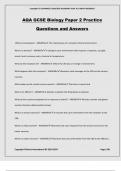Exam (elaborations)
AQA GCSE Biology Paper 2 Practice Questions and Answers
AQA GCSE Biology Paper 2 Practice
Questions and Answers
What is homeostasis? - ANSWER-The maintenance of a constant internal environment.
What is a stimulus? - ANSWER-A change in your environment than requires a response. e.g Light,
sound, touch, pressure, pain, chemical or temperature.
What d...
[Show more]
Preview 4 out of 40 pages
Uploaded on
November 10, 2024
Number of pages
40
Written in
2024/2025
Type
Exam (elaborations)
Contains
Questions & answers
Institution
Prep Tests
Module
Prep Tests
£10.93
100% satisfaction guarantee
Immediately available after payment
Both online and in PDF
No strings attached
Copyright © OLIVIAWEST 2024/2025 ACADEMIC YEAR. ALL RIGHTS RESERVED




